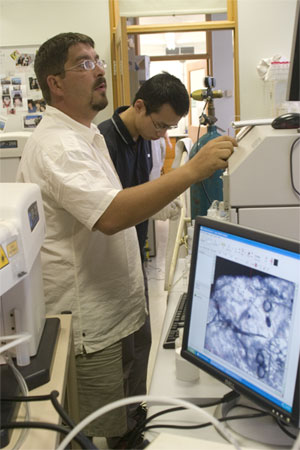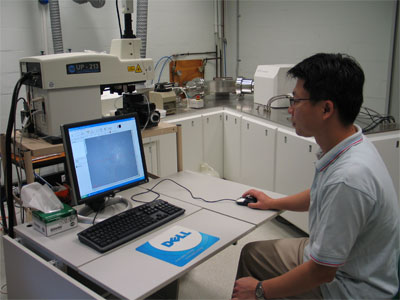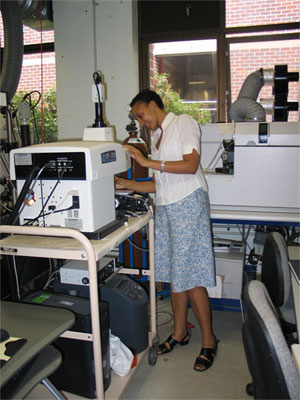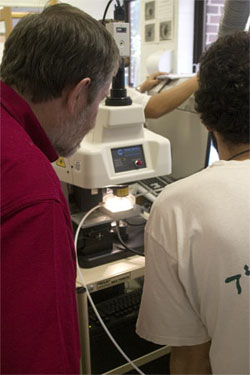Technology development program
 |
 |
 |
 |
Background
GEMOC’s research, training and Industry Interaction programs require a high level of geochemical analytical technology, which is provided by the state-of-the-art facilities available to the Key Centre. Continual development of both technology and innovative analytical and microanalytical approaches is required to meet our research aims and the needs of our industry collaborators. GEMOC develops new analytical strategies as required, to determine the chemical and isotopic composition of geological materials (both solid and fluid) in solution and in situ. Special emphasis is being placed on the development of advanced in situ microbeam methods. These developments are transmitted to industry via open and collaborative research, through technology exchange visits and workshops, and as an integral part of the training program
The analytical instrumentation and support facilities of the Macquarie University Geochemical Analysis Unit (GAU) represent a state-of-the-art geochemical facility.
• The GAU contains:
- a Cameca SX-50 electron microprobe
- a Cameca SX-100 electron microprobe (installed January 2003)
- three Agilent 7500 ICPMS (industry collaboration (two installed October 2004))
- a custom-built UV laser microprobe, usable on the Agilent ICPMS
- five New Wave/Merchantek laser microprobes (two 266 nm, three 213 nm) for the MC-ICPMS and ICPMS laboratories (industry collaboration)
- a New Wave/Merchantek excimer (193 nm) laser microprobe, based on a Lambda Physik OPTex laser
- a Nu Plasma multi-collector ICPMS
- a Nu Plasma high resolution multi-collector ICPMS (installed November 2003)
- a Thermo Finnigan Triton TIMS (installed March 2005)

GEMOC’s clean labs have separate areas for work with radioactive and (here) non-radioactive materials; both require special clothing to keep contamination down.
- a Spectro XLAB2000 energy-dispersive XRF with rocker-furnace sample preparation equipment
- a LECO RC412 H2O-CO2 analyser (delivered September 2003)
- an Ortec Alpha Particle counter
- a New Wave MicroMill
- clean labs and sampling facilities provide infrastructure for ICPMS, XRF and isotopic analyses of small and/or low-level samples

• Experimental petrology laboratories include 4 piston-cylinder presses (pressure to 4 GPa), hydrothermal apparatus, controlled atmosphere furnaces and a multi-anvil apparatus for pressures to 27 GPa.
• The Centre for Isotope Studies has provided access to extraction lines and gas-source mass-spectrometers for stable-isotope analysis of fluids and minerals; it is planned that these facilities will be moved to GEMOC Macquarie.
Alex Corgne and Laure Martin in the Experimental Petrology Lab.
THE GEMOC FACILITY FOR INTEGRATED MICROANALYSIS (FIM) AND MICRO GIS DEVELOPMENT
GEMOC is continuing to develop a unique, world-class geochemical facility, based on in situ imaging and microanalysis of trace elements and isotopic ratios in minerals, rocks and fluids. The Facility for Integrated Microanalysis now consists of four different types of analytical instrument, linked by a single sample positioning and referencing system to combine spot analysis with images of spatial variations in composition (“micro-GIS”). All instruments in the FIM have been operating since mid-1999. Major instruments were replaced or upgraded in 2002-2004 through the $5.125 million DEST Infrastructure grant awarded to Macquarie University with the Universities of Newcastle, Sydney, Western Sydney and Wollongong as partners.
the facility provides:
• The capability to image both major- and trace-element distribution in a sample, as an interpretive tool and as the basis for higher precision spot analysis of trace-element concentrations and isotopic ratios
• Co-registration of images and spot data from different instruments, and use of digitised images to locate spots with a precision of better than 5 µm
• Analytical capability for most elements of the periodic table at ppm to sub-ppb levels
• In situ isotopic-ratio measurement for a range of elements, at the precision required for geologically useful results
• New approaches to data interpretation through application of micro-GIS principles
Electron Microprobe: for imaging and point analysis of major and minor elements
Scanning Nuclear Microprobe: for imaging and point analysis of trace elements at ppm levels
Laser-ablation ICPMS Microprobes: for point analysis of a wide range of trace elements at low ppb levels
Multi-collector Sector ICPMS with laser microprobe: for high-precision in situ analysis of isotopic ratios
Micro-GIS system: A key aspect of the Facility is the co-registration of images and point analyses collected on all instruments. All data for a sample, from any of the instruments or from a bench microscope, are in the same coordinate system and can be overlaid in the computer to enhance interpretation.
When fully developed, images from one instrument will be read into the computer of another instrument and used to guide the analysis. Major-element maps from EMP, or trace-element maps from the nuclear microprobe, can be linked directly to images from petrographic or cathodoluminescence microscopes, BSE or SEM, or to spot analyses.
CURRENT STATUS
Electron microprobe (EMP): The original GEMOC EMP is a CAMECA SX50, installed in 1993; it routinely produces high-precision analyses of major and minor elements with a spatial resolution of one micron, as well as high-quality images of major-element (> 0.1 wt%) distribution over areas up to 45 x 45 mm, by stage-scanning with five fixed wavelength-dispersive spectrometers. In early 1999 the EMP was upgraded with an energy-dispersive X-ray detector to allow rapid and simultaneous mapping of all major elements. A further upgrade in 2004 involved the replacement of the Sun-based operating system with the PC-based SAMx software. In early 2003 a new CAMECA SX100, with a similar configuration of spectrometers, was installed and the SX50 is now used mainly for the imaging and analysis of zircons, in connection with TerraneChron® applications and basic research. The CAMECA SX100 carries the workload of the routine major and minor element analyses for the majority of GEMOC’s research projects. It is fitted with large-area diffracting crystals for improved sensitivity and lower limits of detection.
Olivier Alard and Weiqiang Li carrying out solution analysis on the Agilent ICPMS.
Scanning nuclear microprobe (SNMP): This instrument was built by Dr C.G. Ryan (with GEMOC funding contribution) as a separate beam line on the HIAF particle accelerator at CSIRO, North Ryde. The design incorporates several complementary types of detector, a new high-resolution probe-forming system and an innovative optical system, and provides both images of trace-element distribution and spot analyses, with a lateral resolution of 1-3 µm. Current capabilities cover micro-PIXE, micro-PIGE and quantitative element imaging. Due to the closure of CSIRO's North Ryde site during 2004, the SNMP beam line has been relocated to the accelerator facility at the University of Melbourne.

Norm Pearson giving a workshop on laser-ablation ICPMS techniques at the Agilent product stand at the 16th Goldschmidt Conference, Melbourne.
Laser Ablation ICPMS microprobe (LAM-ICPMS): The original GEMOC LAM was installed in December 1994 using a Perkin-Elmer ELAN 5100 ICPMS (later replaced by an ELAN 6000), attached to a UV laser ablation microprobe built for GEMOC by Memorial University, Newfoundland. In 1999 the ELAN 5100 ICPMS was replaced by a Hewlett Packard 4500, and in 2000 an Agilent 7500S ICPMS was added. In 2004 two new Agilent 7500CS instruments were purchased (one primarily for solution work), and the 7500S replaced the HP4500 for zircon analysis at the end of the year. The 7500S and one 7500CS now routinely provide quantitative analyses of > 30 elements at sub-ppm levels in minerals, glasses and metals, as well as precise U-Pb dating of zircons. The laboratory currently uses three Nd:YAG LAM systems: a Quantel Brilliant laser that can deliver beams of either 266nm or 213nm light, a New Wave UP-266nm system, and a New Wave UP-213 nm system. In November 2005 the New Wave UP-193 nm system (based on a Lambda Physik OPTex excimer laser) was moved from the Nu Plasma to provide an additional option for in-situ analysis of transparent minerals on the 7500CS. Spatial resolution varies with the application, but typically is on the order of 30-40 µm. Each LAM is fitted with a computer-driven sample stage to provide co-registration of X-Y coordinates with the other instruments. On-line data reduction with the GEMOC-developed "GLITTER" software enhances laboratory productivity and data interpretation; the software is marketed internationally by New Wave Research and AccessMQ.
Laser Ablation Multi-collector ICPMS microprobe (LAM-MC-ICPMS): The Facility has two Nu Plasma MC-ICPMS. The first was installed in November 1998 and the other in November 2003. The second Nu Plasma instrument has high-resolution capabilities and a retardation filter to enable U-series work. The instruments combine a laser ablation micro-sampler, an Ar-plasma ionisation source, and a multi-collector magnetic-sector mass spectrometer, to provide high-precision in situ analysis of isotope ratios in geological materials. The instruments use either a New Wave 193 nm system based on an Lambda Physik OPTex excimer laser, a New Wave UP-266 nm Nd:YAG laser, or a New Wave UP-213 nm Nd:YAG laser depending on the application. The MC-ICPMS also can be used in solution mode, with either a standard nebuliser or a desolvating nebuliser, to provide high-precision isotopic analysis of a wide range of elements, including many not accessible by standard thermal ionisation mass spectrometry.
A Triton thermal ionization mass spectrometer (TIMS): The Triton was purchased in 2004 following a successful ARC LIEF application led by Professor Simon Turner and Dr Bruce Schaefer (Monash University), and was installed in March 2005. Following an intensive period of testing the Triton quickly became the primary source of Sr, Nd and Os isotope analyses in the Facility, relieving the MC-ICPMS of this aspect of the analytical workload. The instrument represents the state-of-the-art in thermal ionisation mass spectrometry and its capabilities have contributed to the developments in Ra isotope analysis.
Kuo-Lung Wang measuring the Os-isotope composition of sulfides in xenoliths from Mongolia, using the LAM-MC-ICPMS.
Applications in use and under development include:
Laser Analysis (in situ point analysis)
• U-Pb geochronology of zircons from igneous and metamorphic rocks
• Hf isotope analysis in zircon and rutile for studies of crustal generation, mantle evolution and crust-mantle interaction
• Re-Os dating of sulfides in mantle-derived xenoliths
• Nd isotope analysis in apatites, titanites and other REE-rich minerals
• Sr isotope analysis of carbonates, feldspars, apatites, pyroxenes
• Pb isotope analysis of sulfides and silicates
• Stable isotope ratios of Fe, Mg, Zn, Cu and other cations in appropriate minerals from ore systems and mantle rocks
• Multi-element trace element analysis of silicates, sulfides, oxides and diamonds
Solution Analysis
• Re-Os — determination of mantle depletion ages and isochron ages in whole rocks, ilmenites and chromites; dating of sulfide assemblages in ore bodies
• Lu-Hf — crustal genesis, mantle metasomatism; Lu-Hf dating of garnet peridotites, eclogites, granulites; basalt genesis
• Rb-Sr, Sm-Nd, U-Pb, Pb-Pb — MC-ICPMS and TIMS
• U, Th-series analysis – for dating of young processes, ranging from magma genesis to weathering and erosion
• Multi-element analysis of trace elements in whole-rock samples
PROGRESS IN 2006
1. Facility for Integrated Microanalysis
a. Electron Microprobe: During 2006 the SX50 continued to meet the imaging and analytical demands of the TerraneChron® projects and other zircon-related applications. The SX100 serviced all other projects including several new applications: CL-imaging and trace element analysis of hydrothermal quartz; analysis of platinum group minerals; minor and trace element analysis of metals.
b. Laser-ablation ICPMS microprobe (LAM): During 2006, the LAM laboratory produced large volumes of data for eight Macquarie PhD thesis projects, several projects carried out by international visitors and Honours students, in-house funded research projects and industry collaboration. These projects included the analysis of trace elements in the minerals of mantle-derived rocks, in sulfide minerals and in a range of unusual matrices. Methods were also developed to measure the trace element contents of fused glasses for whole-rock geochemistry. Over 7000 U-Pb analyses of zircons were carried out, related to projects (including TerraneChron® applications) in Antarctica, New Zealand, Scandinavia, Chile, Tibet, China, Italy, southern Africa and Australia. The LAM laboratory also routinely provides data for projects related to mineral exploration (diamonds, base metals, Au) as a value-added service to the industry (see Research Highlights).
U-Pb dating of zircons was carried out on the Agilent 7500S, while one of the two Agilent 7500CS instruments was dedicated to laser-probe applications, and the other set up for solution analysis. The addition of a third ICP-MS allowed uninterrupted periods of time for method development without disrupting the productivity of the laboratory.
Dr Chuma Keswa visited to learn GEMOC’s LAM-ICPMS techniques for use in the De Beers laboratories in Johannesburg.
c. MC-ICPMS: The rapid growth in the use of the TerraneChron® application (see Research Highlights), coupled with the demand for in situ Re-Os analysis and stable isotope analysis, led to severe competition for instrument time on the MC-ICPMS. An order was placed early in 2003 for a second instrument, funded by the DEST infrastructure grant, and this instrument (Nu034) was installed in November 2003. Nu034 is equipped with a retardation filter and high-resolution capability, specifically for U-series analysis. In 2004-2005 methods for the analysis of other isotopic systems (Re-Os, Sm-Nd, Lu-Hf, Pb) were transferred to Nu034, and considerable time was spent in doing comparisons of the performance of Nu005 and Nu034 with respect to these isotopic systems.
 In 2005 significant advances were made in the analysis of 'non-traditional' stable isotopes (see Research Highlights) and included the development of separation techniques and analytical protocols for Tl, Fe and Ni isotopes. These activities continued in 2006 along with a renewed effort to improve separation techniques for Cu and Zn isotopes in a wide range of rock compositions from ultramafic to granitic. Preliminary steps were taken to establish separation and analytical methods for the measurement of Li isotopes. A major project continued on the isotopic composition of Cu and Ni in sulfides and whole rocks from major ore bodies, in a collaboration with Anglo American. Major applications during 2006 using in situ techniques continued to centre on the high-precision analysis of Hf in zircons to trace lithosphere evolution and magma-mixing histories in granitic rocks and Re-Os dating of single grains of Fe-Ni sulfides in mantle-derived rocks. In-situ Hf isotopes were measured in zircons from Antarctica, New Zealand, Scandinavia, Chile, Tibet, China, Italy, southern Africa and Australia. We carried out Re-Os studies on xenoliths from western USA, South Africa, Vietnam, eastern China and Taiwan, Ethiopia, Siberia and Sicily.
In 2005 significant advances were made in the analysis of 'non-traditional' stable isotopes (see Research Highlights) and included the development of separation techniques and analytical protocols for Tl, Fe and Ni isotopes. These activities continued in 2006 along with a renewed effort to improve separation techniques for Cu and Zn isotopes in a wide range of rock compositions from ultramafic to granitic. Preliminary steps were taken to establish separation and analytical methods for the measurement of Li isotopes. A major project continued on the isotopic composition of Cu and Ni in sulfides and whole rocks from major ore bodies, in a collaboration with Anglo American. Major applications during 2006 using in situ techniques continued to centre on the high-precision analysis of Hf in zircons to trace lithosphere evolution and magma-mixing histories in granitic rocks and Re-Os dating of single grains of Fe-Ni sulfides in mantle-derived rocks. In-situ Hf isotopes were measured in zircons from Antarctica, New Zealand, Scandinavia, Chile, Tibet, China, Italy, southern Africa and Australia. We carried out Re-Os studies on xenoliths from western USA, South Africa, Vietnam, eastern China and Taiwan, Ethiopia, Siberia and Sicily.
d. Scanning Nuclear Microprobe: The closure of the CSIRO North Ryde site forced the shutdown of the SNMP in late 2003. The beam line was dismantled, and re-installed on the University of Melbourne accelerator during 2004. It is in operation for 2-3 days/week.
Yakov Weiss (Hebrew University of Jerusalem, Israel) and Bill Griffin using the LAM-ICPMS to analyse the trace-element composition of diamonds for Yakov’s PhD project.
e. Laboratory development: The new clean-room facility, which is being used primarily for isotope separations, opened in April 2004. It provides an ultra-clean environment within a 3-stage pressurised volume; it contains 6 Class 3500 work areas, three for radioactive isotopes and three for other activities.
f. Software: GLITTER ( (GEMOC Laser ICPMS Total Trace Element Reduction) software is our on-line interactive program for quantitative trace element analysis and features dynamically linked graphics and analysis tables. This package provides the first real-time interactive data reduction for LAM-ICPMS analysis, allowing inspection and evaluation of each result before the next analysis spot is chosen. Its capabilities include the on-line reduction of U-Pb data. The use of GLITTER has greatly increased both the flexibility of analysis and the productivity of the laboratory. New Wave Research market the software together with their laser microprobe equipment; GEMOC provides customer service and backup through AccessMQ (formerly Macquarie Research Limited). During 2006 a further 12 copies of GLITTER were sold bringing the total number in use to more than 100 worldwide, in forensics and materials science, as well as earth science applications. During 2005, Will Powell, Norm Pearson and Chris Ryan began updating GLITTER to version 4.4, and this version is now provided to all new Glitter purchases and is available as an upgrade to existing installations. Will Powell continued in his role in GLITTER technical support and software development through 2006.

Valeria Murgulov using the Agilent 7500 for U/Pb dating of zircons with the help of the GLITTER software.
2. Laser development
GEMOC continues to benefit from an industry partnership with New Wave Research (formerly Merchantek EO), a major US manufacturer of laser ablation systems. The mobility of the probes has allowed them to be used on the quadrupole ICPMS instruments as well, in a range of applications. A Merchantek/New Wave Research 193 nm excimer system based on a Lambda Physik OPTex laser, delivered in March 2002 was repaired and realigned late in 2005 for use in diamond analysis. Three more New Wave laser systems, acquired during 2004 (a UP-266 nm and two UP-213 nm), represented a major upgrading of the instrument park and giving redundancy to limit downtime. The 213 nm lasers are now used for most of the zircon analytical work including both U-Pb and Hf isotope analyses, especially where small grains are being analysed. The 266 nm systems have proven most useful for analysis of sulfides, and for other stable-isotope applications.
3. Energy dispersive XRF
A Spectro XLAB2000 energy-dispersive X-ray spectrometer, installed in November 2000 in a joint venture with Tasman Resources, continued to produce high-quality major- and trace-element data. During 2006 over 1200 samples were analysed for major and trace elements, providing data to student theses, in-house research projects, and industry collaborators. The number of samples analysed in 2006 was lower than in previous years due to a 3-month downtime while the detector was refurbished.
A LECO RC412 H2O-CO2 analyser, installed in September 2003 to replace an outdated unit, is providing high-quality analyses to complete whole-rock analyses by XRF and solution-ICPMS.
4. Solution analysis
3. Energy dispersive XRF
A Spectro XLAB2000 energy-dispersive X-ray spectrometer, installed in November 2000 in a joint venture with Tasman Resources, continued to produce high-quality major- and trace-element data. During 2006 over 1200 samples were analysed for major and trace elements, providing data to student theses, in-house research projects, and industry collaborators. The number of samples analysed in 2006 was lower than in previous years due to a 3-month downtime while the detector was refurbished.
A LECO RC412 H2O-CO2 analyser, installed in September 2003 to replace an outdated unit, is providing high-quality analyses to complete whole-rock analyses by XRF and solution-ICPMS.
4. Solution analysis
An Agilent 7500CS ICPMS is regularly used to provide trace-element analyses of dissolved rock samples for the projects of GEMOC researchers and students, and external users, supplementing the data from the XRF.
The in situ analysis of the Rb-Sr, Lu-Hf, Sm-Nd and Re-Os systems by laser ablation microprobe has required the development of corrections for isobaric overlaps (eg 87Rb on 87Sr), and has demonstrated that these corrections can be done with very high precision in the Nu Plasma MC-ICPMS. This has allowed us to simplify the ion-exchange chemistry traditionally used to obtain clean element separations for standard mass-spectrometry analysis. A new scheme for the dissolution of rocks, separation of Sr, Nd, Hf and Pb, and isotopic analysis using the MC-ICPMS in solution mode provides precise whole-rock isotopic analyses that are faster, simpler and ultimately cheaper than those obtained by traditional methods.
During 2006 further developments were made in the separation of ‘non-traditional’ isotopes, with significant improvements in the separation of Cu and Ni isotopes. The permanent availability of one of the Agilent 7500CS for solution analysis greatly benefited the development of the separation techniques. Advances were also made in the U-series chemistry with the development of separation methods for Ra and 210Pb.
5. Centre for Isotope Studies (CIS)
The Centre for Isotope Studies (CIS) was a consortium operated by the geoscience departments of the New South Wales Universities, CSIRO Exploration and Mining, and Petroleum Resources using jointly-purchased mass-spectrometers housed at the CSIRO in North Ryde. Dr Anita Andrew developed techniques for C-isotope analysis of diamonds using very small sample sizes (0.1 mg), which allows analysis of microdiamonds or multiple fragments of different zones of small stones. This is now an essential part of GEMOC capabilities. CSIRO's North Ryde site was closed in 2004, but the laboratories are still in operation. A plan is in place for Dr Andrew to move the stable isotope facilities to GEMOC, where they will form a self-funded entity, and GEMOC will continue to benefit from this collaboration.

 GEMOC ARC National Key Centre
GEMOC ARC National Key Centre